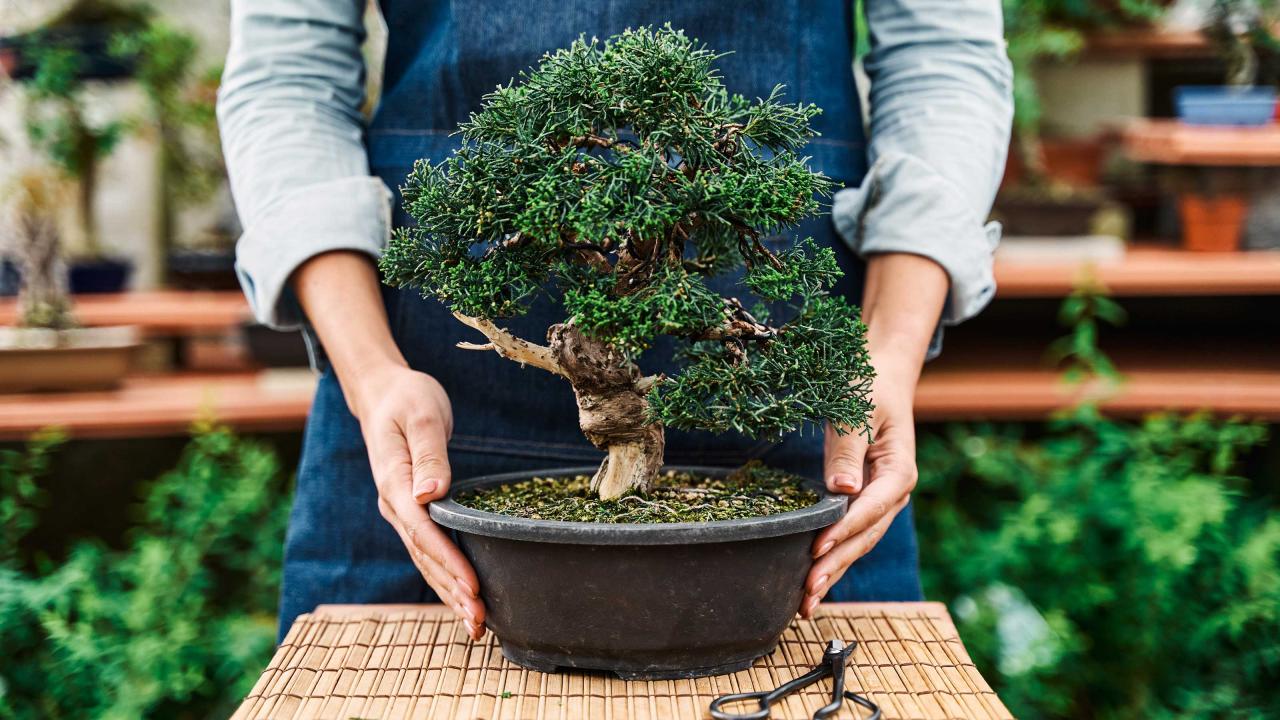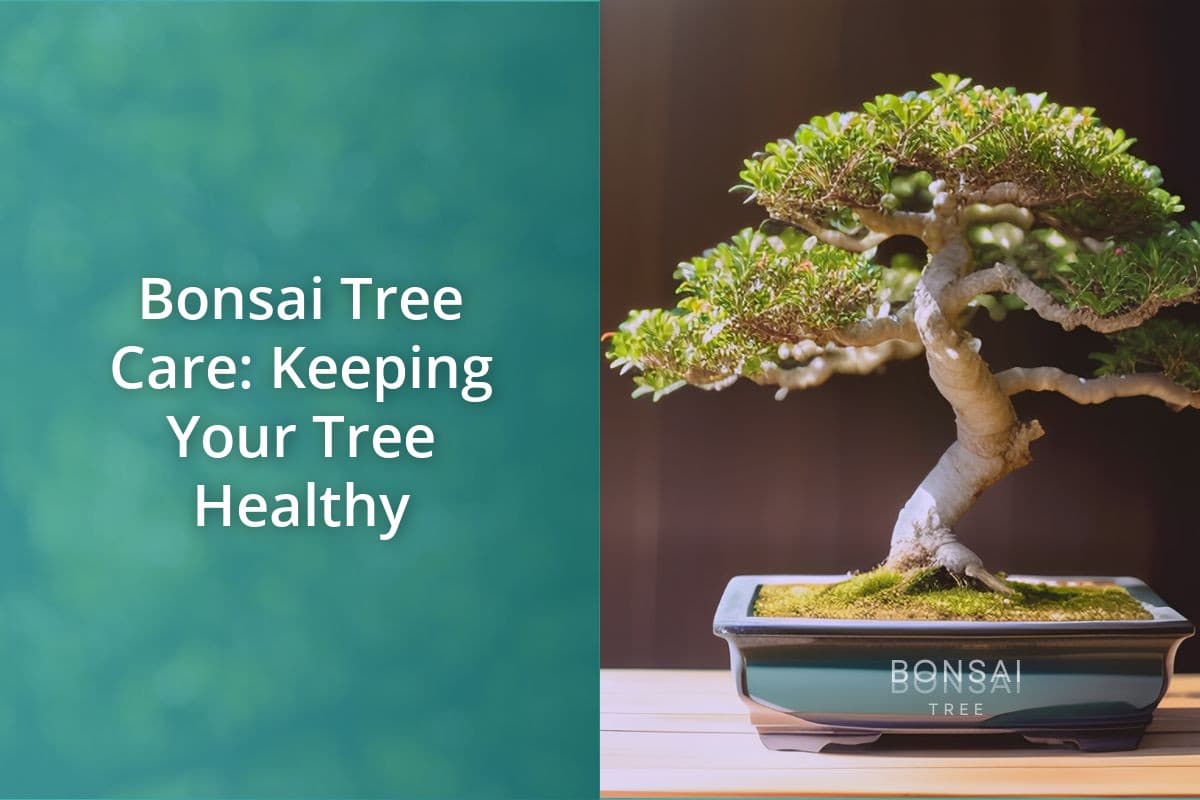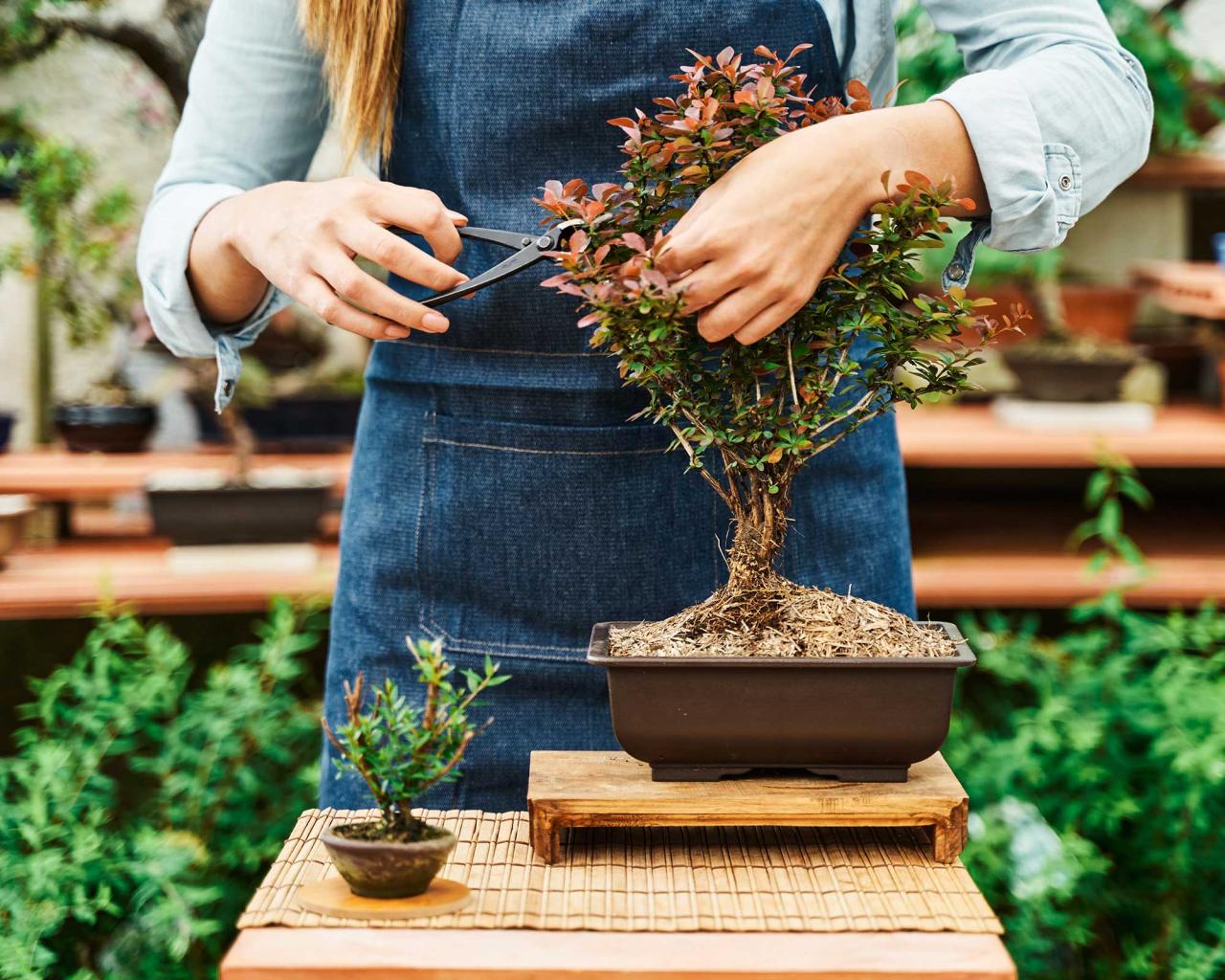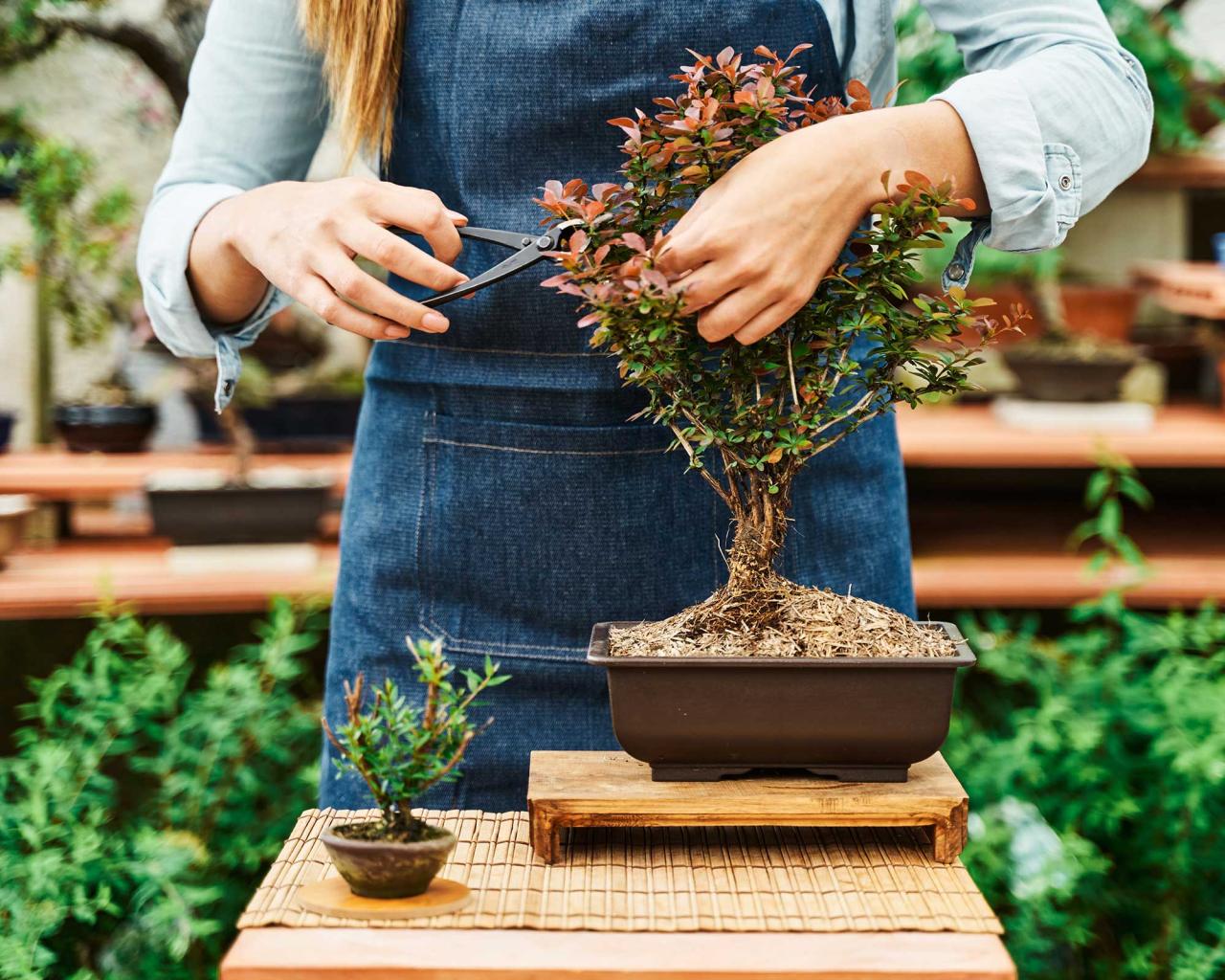Top Tips for Keeping Your Bonsai Tree Healthy: Bonsai, the art of cultivating miniature trees, offers a captivating blend of nature and artistry. These living sculptures, often perceived as delicate and demanding, require a dedicated approach to thrive. Understanding the fundamentals of bonsai care is crucial for nurturing these miniature wonders, ensuring they flourish and bring joy for years to come.
From understanding their unique characteristics to mastering essential care practices, this comprehensive guide provides a roadmap to success in the world of bonsai. It delves into the intricacies of bonsai care, exploring everything from optimal growing conditions and watering techniques to pruning and shaping, repotting, and pest management.
Understanding Bonsai Basics

Bonsai, the art of cultivating miniature trees in containers, is a fascinating practice that combines horticultural skill with artistic vision. Bonsai trees are not simply small versions of their larger counterparts; they are meticulously shaped and maintained to resemble mature trees in nature, capturing the essence of their species in a compact form.
The Art and Philosophy of Bonsai
Bonsai is not merely a horticultural practice but a profound art form deeply rooted in Eastern philosophy. The process of cultivating a bonsai tree is a meditative journey, fostering patience, discipline, and a deep appreciation for the natural world. Bonsai embodies the concept of “wabi-sabi,” a Japanese aesthetic that finds beauty in imperfection and transience.
Maintaining the health of your bonsai tree requires a consistent approach. From ensuring proper watering to providing adequate sunlight, every step plays a crucial role in its well-being. For a comprehensive guide on fostering a strong and healthy bonsai, check out Bonsai Care Tips for Growing Strong and Healthy Trees.
By implementing these tips, you can nurture your bonsai and witness its growth and resilience, ensuring it thrives for years to come.
The imperfections of a bonsai tree, its unique shape, and the marks of time on its bark, contribute to its overall aesthetic appeal. Bonsai is a living testament to the interconnectedness of nature, the cycle of life and death, and the delicate balance between human intervention and natural processes.
Types of Bonsai Trees
Bonsai trees can be created from a wide variety of species, each with its own unique characteristics and aesthetic appeal.
- Conifers: Conifers, such as pines, junipers, and firs, are popular choices for bonsai due to their resilience and ability to withstand shaping. Their evergreen foliage provides year-round interest, and their strong, sturdy branches create a sense of strength and longevity.
- Deciduous Trees: Deciduous trees, such as maples, elms, and cherries, are known for their beautiful seasonal changes. Their foliage turns vibrant colors in autumn before shedding for the winter, adding a dynamic element to the bonsai display.
- Tropical Trees: Tropical trees, such as ficus, bougainvillea, and jade, can also be cultivated as bonsai. They thrive in warm climates and can be brought indoors during colder months, adding a touch of exotic beauty to any home.
Origins of Bonsai
The origins of bonsai can be traced back to ancient China, where the practice of cultivating miniature trees in pots evolved from the art of penjing. Penjing, meaning “tray landscape,” involved creating miniature landscapes that captured the essence of nature.
The practice of bonsai spread to Japan in the 14th century, where it was refined and developed into the art form we know today.
Essential Bonsai Care Practices

Providing the right conditions for your bonsai tree is crucial for its health and longevity. Understanding the optimal growing conditions and practicing proper care techniques will ensure your bonsai thrives and remains a beautiful addition to your home or garden.
Optimal Growing Conditions
The ideal growing conditions for a bonsai tree depend on the specific species. However, there are some general guidelines that apply to most bonsai trees.
- Sunlight:Bonsai trees need ample sunlight, but the amount varies depending on the species. Most bonsai trees prefer a location with at least six hours of direct sunlight per day. However, some species, like Japanese maples, prefer partial shade, especially during the hottest months.
- Temperature:Bonsai trees are generally hardy and can tolerate a wide range of temperatures. However, they are sensitive to extreme temperatures, especially during the winter months. Most bonsai trees thrive in temperatures between 60°F and 80°F (15°C and 27°C). During the winter, it is essential to protect your bonsai from frost and freezing temperatures.
- Humidity:Bonsai trees prefer high humidity levels. If you live in a dry climate, you may need to mist your bonsai regularly to maintain adequate humidity levels. You can also use a humidifier to increase the humidity in the surrounding area.
- Air Circulation:Good air circulation is essential for preventing diseases and pests. Ensure your bonsai tree is in a well-ventilated area, allowing for fresh air to circulate around the plant. Avoid placing your bonsai in a stuffy or stagnant environment.
Watering Techniques
Proper watering is essential for the health of your bonsai tree. Overwatering or underwatering can lead to root rot or dehydration, both of which can be fatal to your bonsai.
- Frequency:The frequency of watering depends on several factors, including the species of bonsai, the size of the pot, the season, and the climate. During the growing season, you may need to water your bonsai daily or even twice a day.
In the winter, when the tree is dormant, you may only need to water it once a week or even less.
- Water Quality:Use clean, room-temperature water for watering your bonsai. Avoid using tap water that contains chlorine or fluoride, as these chemicals can harm your bonsai. Consider using rainwater or bottled water if your tap water is heavily chlorinated.
- Watering Method:The best way to water your bonsai is to soak the soil thoroughly until water drains from the drainage holes. Allow the soil to dry slightly between waterings. Avoid overwatering, as this can lead to root rot.
Fertilizing Bonsai Trees
Bonsai trees require regular fertilization to provide them with the nutrients they need to grow and thrive.
- Fertilizer Type:There are various types of fertilizers available for bonsai trees, including liquid, granular, and slow-release fertilizers. Choose a fertilizer specifically designed for bonsai trees, as these fertilizers contain the appropriate balance of nutrients for these small trees.
- Fertilization Schedule:The fertilization schedule depends on the species of bonsai, the growing season, and the type of fertilizer used. Generally, you should fertilize your bonsai tree every two to four weeks during the growing season (spring and summer). During the dormant season (fall and winter), you can reduce the frequency of fertilization to once a month or even less.
- Fertilizer Application:Apply fertilizer to the soil around the base of the bonsai tree, avoiding direct contact with the roots. Use a diluted solution of liquid fertilizer or sprinkle granular fertilizer evenly around the base of the tree.
Pruning and Shaping Techniques

Pruning and shaping are essential aspects of bonsai care, allowing you to control the tree’s growth and create a desired aesthetic. These techniques involve strategically removing branches and leaves, guiding the tree’s growth, and maintaining its overall health.
Types of Pruning Techniques, Top Tips for Keeping Your Bonsai Tree Healthy
Different pruning techniques are used for various purposes, including maintaining the bonsai’s shape, promoting branching, and controlling its overall size.
Keeping your bonsai tree healthy requires a dedicated approach, and understanding the nuances of proper care is essential. For a comprehensive guide covering all aspects of bonsai care, from watering and fertilizing to pruning and repotting, check out How to Care for a Bonsai Tree: A Comprehensive Guide.
This guide will provide you with the knowledge you need to create a thriving bonsai that will bring you years of enjoyment.
- Pinch Pruning:This technique involves removing the growing tips of branches, encouraging the development of new shoots and denser foliage. Pinch pruning is often used on young trees to promote bushier growth.
- Leaf Pruning:Leaf pruning involves removing individual leaves or entire sets of leaves to reduce the tree’s overall size and encourage the growth of smaller leaves. This technique is commonly used on deciduous trees.
- Cutting Back:Cutting back involves removing larger branches or stems to control the tree’s shape and size. This technique is used to remove unwanted branches or to reduce the tree’s overall height.
- Root Pruning:Root pruning is a technique used to control the tree’s growth and maintain its overall health. It involves removing a portion of the tree’s roots, typically during repotting. Root pruning encourages the development of a strong root system and helps to maintain the tree’s overall size.
Shaping Bonsai Trees
Shaping a bonsai tree involves a combination of pruning, wiring, and other techniques to create a desired aesthetic.
- Initial Shaping:The initial shaping of a bonsai tree involves selecting a design and using pruning techniques to establish the basic structure. This may involve removing branches, reducing the tree’s height, and creating a balanced framework.
- Branch Placement:The placement of branches is crucial for creating a visually appealing bonsai. Use pruning techniques to adjust the angles and positions of branches, ensuring they are distributed evenly and harmoniously.
- Foliage Development:Bonsai shaping also involves controlling the density and distribution of foliage. Pinch pruning and leaf pruning are used to create a balanced and aesthetically pleasing canopy.
The Role of Wire in Bonsai Shaping
Wire is a vital tool in bonsai shaping, allowing you to bend and guide branches into desired positions.
- Types of Wire:Bonsai wire is available in various materials, including aluminum, copper, and stainless steel. The choice of wire depends on the tree’s species, the thickness of the branches, and the desired shaping effect.
- Wiring Techniques:Proper wiring techniques are crucial to avoid damaging the tree. The wire should be applied snugly but not so tightly that it constricts the branch. Always remove the wire once the branch has reached its desired position.
- Wire Removal:Wire should be removed once the branch has set in its desired position. If left on for too long, the wire can cut into the bark and damage the tree.
Proper Wiring Methods
Here are some basic steps for wiring bonsai branches:
- Prepare the Branch:Remove any dead or unwanted leaves or branches from the area where you will be applying the wire.
- Apply the Wire:Wrap the wire around the branch, starting at the base and working your way towards the tip. Ensure the wire is applied snugly but not too tightly. The wire should be secured at the base and tip of the branch.
- Shape the Branch:Once the wire is in place, gently bend the branch into the desired position. Avoid making sharp bends, as this can damage the branch.
- Maintain the Shape:Check the wire periodically and adjust it as needed. Once the branch has set in its desired position, the wire can be removed.
Pest and Disease Management
Bonsai trees, being miniature versions of their larger counterparts, are susceptible to the same pests and diseases that affect their full-sized relatives. While bonsai care practices help minimize these threats, understanding and addressing these issues is crucial for maintaining the health and longevity of your bonsai.
Common Pests and Diseases
Pests and diseases can significantly impact the health and appearance of bonsai trees. Identifying common threats and understanding their characteristics is essential for timely intervention.
- Aphids:These tiny insects, often green or black, feed on plant sap, causing leaf distortion and weakening the tree.
- Scale Insects:These immobile insects, resembling small bumps on branches and leaves, suck sap and can cause yellowing and leaf drop.
- Mealybugs:These white, cottony insects are found in clusters and feed on plant sap, leading to stunted growth and leaf discoloration.
- Spider Mites:These tiny, spider-like creatures create webs on leaves and feed on sap, causing yellowing and browning of leaves.
- Fungus Gnats:These small, flying insects lay eggs in the soil, and their larvae feed on roots, damaging the root system.
- Root Rot:This fungal disease occurs in overly wet soil, causing root damage and eventually killing the tree.
- Powdery Mildew:This fungal disease appears as a white, powdery coating on leaves, affecting photosynthesis and weakening the tree.
- Leaf Spot:This fungal disease causes brown or black spots on leaves, leading to leaf drop and weakening the tree.
Preventative Measures
Proactive measures are crucial to minimize the risk of pest and disease infestations.
- Regular Inspection:Regularly inspecting your bonsai for any signs of pests or diseases is vital for early detection and intervention.
- Proper Watering:Avoid overwatering, as it creates favorable conditions for root rot. Ensure good drainage to prevent waterlogging.
- Appropriate Soil:Use well-draining bonsai soil, which provides aeration and prevents water retention.
- Hygiene:Clean your bonsai tools regularly to prevent the spread of pests and diseases.
- Quarantine:Quarantine new bonsai trees for a period before introducing them to your collection to prevent potential infestations.
Treatment Methods
Once pests or diseases are identified, appropriate treatment methods should be implemented.
- Insecticidal Soap:This solution effectively controls aphids, mealybugs, and spider mites. It works by disrupting their cell membranes.
- Neem Oil:This natural oil is effective against a wide range of pests, including aphids, mealybugs, and scale insects. It acts as a repellent and disrupts their feeding.
- Horticultural Oil:This oil suffocates and kills pests by blocking their breathing pores. It is effective against scale insects and mealybugs.
- Fungicides:These chemicals are used to control fungal diseases, such as root rot, powdery mildew, and leaf spot.
- Beneficial Insects:Introducing beneficial insects, such as ladybugs or lacewings, can help control pests like aphids and mealybugs. These insects prey on the pests, providing natural pest control.
- Pruning:Removing infected branches or leaves can help prevent the spread of disease. It is important to sterilize pruning tools before and after use to avoid spreading the disease.
Bonsai Aesthetics and Design
Bonsai aesthetics and design are integral to the art form, emphasizing the creation of miniature trees that capture the essence of their full-sized counterparts while reflecting natural beauty and harmony. Bonsai artists strive to evoke a sense of tranquility and serenity through the careful manipulation of the tree’s form, branches, and foliage.
Bonsai Styles
Bonsai styles are diverse and represent different aspects of nature, reflecting the artist’s interpretation of the tree’s natural growth habit and the desired aesthetic.
- Formal Upright (Chokkan):This style is characterized by a straight, single trunk with a conical shape, symbolizing strength and longevity. The apex of the tree is typically positioned slightly off-center, creating a dynamic balance.
- Informal Upright (Moyogi):This style features a slightly curved trunk that creates a more natural and dynamic appearance. The tree’s branches grow in a more asymmetrical pattern, reflecting the natural growth of trees in the wild.
- Slanting (Shakan):This style showcases a trunk that leans dramatically, creating a sense of movement and tension. The tree’s branches often grow in a cascading pattern, adding to the dynamic composition.
- Cascade (Kengai):This style is characterized by a trunk that cascades over the pot’s edge, resembling a tree growing on a cliff or mountainside. The branches are often trained to droop downwards, creating a graceful and flowing effect.
- Semi-Cascade (Han-Kengai):This style is similar to the cascade style but with a trunk that does not cascade over the pot’s edge. The branches are trained to droop downwards, creating a graceful and flowing effect.
- Broom (Hokidachi):This style features a single trunk with branches that spread out horizontally like a broom. The tree’s apex is typically positioned in the center, creating a symmetrical and balanced appearance.
- Literati (Bunjingi):This style is characterized by a slender trunk with sparse foliage, reflecting the elegance and simplicity of traditional Chinese calligraphy. The tree’s branches are often trained to grow in a sweeping and graceful pattern.
- Windswept (Fukinagashi):This style captures the effect of wind on a tree, with branches that are trained to grow in a direction that appears to be blown by the wind.
- Group Planting (Yose-Ue):This style features a group of trees planted together in a single pot, creating a sense of community and interdependence. The trees are typically chosen for their complementary shapes and colors, creating a harmonious composition.
Famous Bonsai Trees
Famous bonsai trees have become icons in the art form, representing the culmination of skill, patience, and artistry.
- The “Oldest Bonsai in the World” (Japanese Black Pine):This tree, estimated to be over 800 years old, resides in the Omiya Bonsai Village in Saitama, Japan. Its age and meticulously crafted form make it a revered treasure.
- “The Emperor’s Bonsai” (Japanese Black Pine):This bonsai, owned by the Imperial Household Agency of Japan, is a magnificent specimen known for its intricate branches and its history dating back centuries.
- “The Great Banyan Tree” (Ficus benghalensis):This bonsai, located at the National Arboretum in Washington, D.C., is a stunning example of a tropical bonsai with a sprawling canopy and intricate root system.
- “The Chinese Juniper” (Juniperus chinensis):This bonsai, housed in the National Bonsai & Penjing Museum in Washington, D.C., is renowned for its intricate branching and its elegant, windswept style.
Conclusive Thoughts: Top Tips For Keeping Your Bonsai Tree Healthy
Maintaining the health and beauty of your bonsai tree is a rewarding journey that deepens your connection with nature. By following these tips, you can create a thriving miniature ecosystem that will bring you joy for years to come. Remember, patience, attention to detail, and a deep appreciation for the art of bonsai are key to cultivating these living masterpieces.
Helpful Answers
How often should I fertilize my bonsai tree?
The frequency of fertilizing depends on the specific species and growing season. Generally, bonsai trees benefit from regular fertilization during their active growing period, typically from spring to early fall.
What are the signs of an overwatered bonsai tree?
Overwatering is a common problem for bonsai owners. Signs include yellowing leaves, wilting, and a soggy soil surface. If you suspect overwatering, allow the soil to dry out completely before watering again.
Can I prune my bonsai tree during any season?
While pruning is generally recommended during the active growing season, some species can be pruned during the dormant period. Consult a bonsai expert or a reputable resource for specific pruning recommendations based on your tree’s species.
